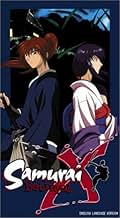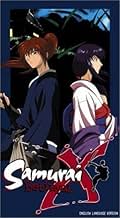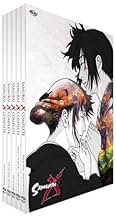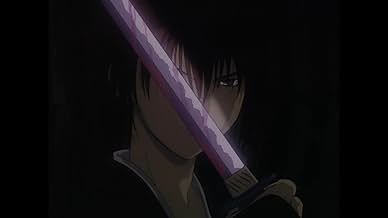Kenshin, el guerrero samurái: Recuerdos
Título original: Rurôni Kenshin: Meiji kenkaku romantan - Tsuioku-hen
CALIFICACIÓN DE IMDb
8.6/10
17 k
TU CALIFICACIÓN
En la era de la Restauración Meiji de Japón, un asesino recupera su humanidad.En la era de la Restauración Meiji de Japón, un asesino recupera su humanidad.En la era de la Restauración Meiji de Japón, un asesino recupera su humanidad.
Explorar episodios
Argumento
¿Sabías que…?
- TriviaAlthough the of Kenshin's life depicted in this OVA series was also detailed in the original manga, the TV series "Rurouni Kenshin: Meiji kenkaku roman tan" (1996) never mentions Tomoe by name, but Hiko does mention ask Kenshin about his lost love at Tomoe's gravesite in Kyoto. The only characters aside from Kenshin that also appear in the TV series are Saito, Hiko, and assumedly Shishio (the unnamed assassin).
- Créditos curiososThe original DVDs from ADV Films replaced the original Japanese title card to read: 'Samurai X: Trust' and 'Samurai X: Betrayal'. This is restored for the Director's Cut DVD.
- Versiones alternativasThe original DVDs from ADV Films feature the original 4 OVA episodes on two DVDs. These episodes were later combined into a Director's Cut DVD.
- ConexionesFeatured in Anime Network Commercial 1 (2004)
- Bandas sonorasQuiet Life
by Taku Iwasaki
Opinión destacada
Forget the famous Rurouni Kenshin TV series. This has nothing to do with it. Well, yes, it's supposed to be a prequel, but the tone, mood and depth of it makes it a completely different story. It's a lyric and very adult tale about love, death, politics and betrayal that deserved, not only a theatrical release, but also massive exposure.
Production values are extraordinary and it's packed with more expressive resources than all western animation ever. Look specially for one of the best representations of smell in the history of filmmaking.
But the best part is the story. Layer over layer of meaning and symbolism create a tight, dark and deep tale. Nothing is said, nothing is shown that doesn't bear deep significance, be it a cryptic sentence, a shot of a child's toy or a slash through the face.
And then there's the fights. When "Crouching Tiger, Hidden Dragon" opened everybody talked about how the fights revealed character. Well, Rurouni Kenshin does the same thing much better, and it doesn't need 10 minutes each time. The fights are short and brutal, swords actually cut the flesh, but there's so much being told each time.
One of the most beautiful things here is what's left off screen. Rurouni Kenshin is a historical epic, but history isn't shown directly to the viewer, it isn't spelled out for you. We focus on the characters. They go through history, sometimes they even change it, but we are not shown the politics and the fights for power. We stay with Kenshin, an assassin, a mere pawn in those fights. We see the killing and then we hear the vague echoes of what it causes. The story is moved forward, but we have to build it back together with the information we receive through Kenshin's eyes. Yes, this is what critics mean when they talk about a `demanding' film.
Rurouni Kenshin is a work of art. Well worth your time and money. It comes in two one-hour volumes (two chapters each), but the best way to experience it is seeing them all back to back, as a two hour feature film. Two thumbs up and go get it.
Production values are extraordinary and it's packed with more expressive resources than all western animation ever. Look specially for one of the best representations of smell in the history of filmmaking.
But the best part is the story. Layer over layer of meaning and symbolism create a tight, dark and deep tale. Nothing is said, nothing is shown that doesn't bear deep significance, be it a cryptic sentence, a shot of a child's toy or a slash through the face.
And then there's the fights. When "Crouching Tiger, Hidden Dragon" opened everybody talked about how the fights revealed character. Well, Rurouni Kenshin does the same thing much better, and it doesn't need 10 minutes each time. The fights are short and brutal, swords actually cut the flesh, but there's so much being told each time.
One of the most beautiful things here is what's left off screen. Rurouni Kenshin is a historical epic, but history isn't shown directly to the viewer, it isn't spelled out for you. We focus on the characters. They go through history, sometimes they even change it, but we are not shown the politics and the fights for power. We stay with Kenshin, an assassin, a mere pawn in those fights. We see the killing and then we hear the vague echoes of what it causes. The story is moved forward, but we have to build it back together with the information we receive through Kenshin's eyes. Yes, this is what critics mean when they talk about a `demanding' film.
Rurouni Kenshin is a work of art. Well worth your time and money. It comes in two one-hour volumes (two chapters each), but the best way to experience it is seeing them all back to back, as a two hour feature film. Two thumbs up and go get it.
- NestorForjan
- 23 nov 2002
- Enlace permanente
Selecciones populares
Inicia sesión para calificar y agrega a la lista de videos para obtener recomendaciones personalizadas
- How many seasons does Rurouni Kenshin: Trust and Betrayal have?Con tecnología de Alexa
Detalles
- Fecha de lanzamiento
- País de origen
- Idioma
- También se conoce como
- Rurouni Kenshin: Trust and Betrayal
- Productoras
- Ver más créditos de la compañía en IMDbPro
- Tiempo de ejecución30 minutos
- Color
- Mezcla de sonido
- Relación de aspecto
- 1.33 : 1
Contribuir a esta página
Sugiere una edición o agrega el contenido que falta

Principales brechas de datos
What is the French language plot outline for Kenshin, el guerrero samurái: Recuerdos (1999)?
Responda




















